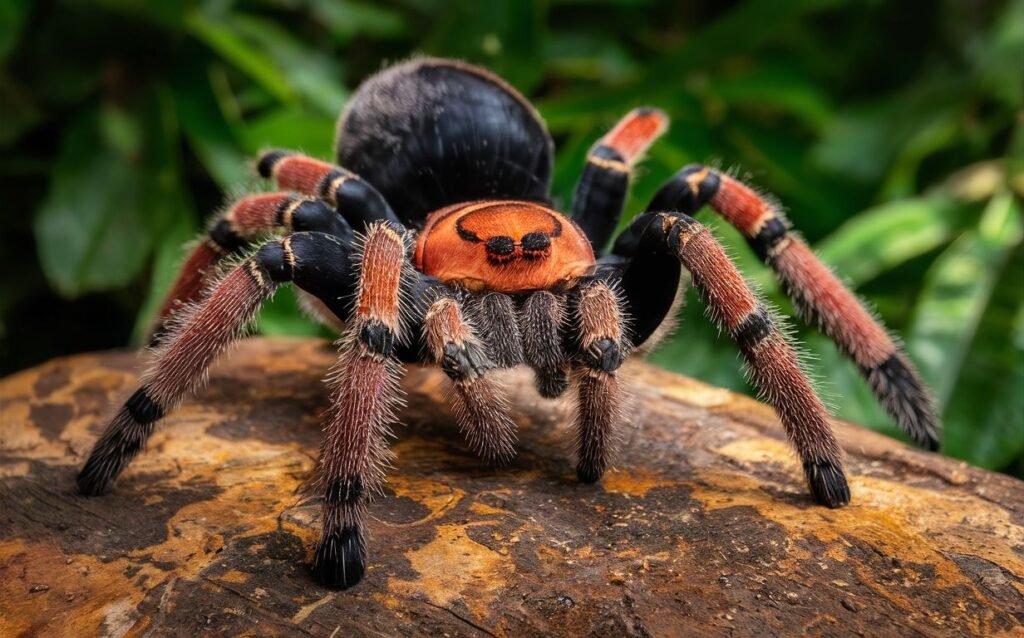The most common pet spider is the tarantula, and they can live from 10 to 15 years or more, which is a big commitment! Fortunately, they are relatively easy to handle and look after, don’t require much space, and can be a unique and fascinating pet. Read through our tips and advice first, and then consider whether you’ll still be as committed to spider ownership as you initially thought.
Before buying a spider, ensure that you have done your research and are confident that you can raise a happy, healthy spider.
Tarantula spider Species
Tarantulas belong to a group of large and hairy spiders (arachnids) that belong to the ‘new world’ Theraphosidae subfamily of spiders.
As of 2019, over 900 species belong to this family, and they are commonly referred to as tarantulas.
The most common tarantula species are
- the Chilean Rose,
- Brazilian Black,
- Mexican Red Knee,
- Curly Hair,
- Chile Gold Burst,
- Mexican Blood Leg
- Chaco Golden Knee
The Chaco Golden Knee originates from North and South America. They are the most docile species, unlike those originating from Africa and Asia.
The spiders from Africa and Asia aren’t recommended as pets as their venom is more potent, aggressive, and more likely to attack if disturbed).
Tarantulas and wolf spiders often make excellent exotic pets and can be very interesting to watch.
They are readily available due to their willingness to breed in captivity. They don’t make noise, they don’t smell, and are pretty easy to look after!
The Chilean Rose is by far the most popular tarantula for pet ownership. It is calm and docile, ideal if you’re looking for your first tarantula.

Tarantulas range in size, with their overall leg span growing as long as 30cm and their bodies ranging between 2.5 and 10cm.
Their appearances can vary between species; for example, the Chilean Rose tarantula has tan brown and lighter pinky shades and looks very hairy, whereas the Brazilian Black is jet black and quite bulky. Females are normally bigger than males and are also more brightly colored.
The anatomy of the tarantula’s body consists of two parts — the cephalothorax and the abdomen. The legs, pedipalps (an extra pair of pincers), and fangs are attached to the cephalothorax, and spinnerets are found at the tip of the abdomen, which produce silk for making webs.
Housing your spider
Here’s a list of a few things you will need to house your tarantula:
- A tank/terrarium (fish tanks are suitable)
- Shallow water bowl
- Substrate (1-4 inches for the bottom of the tank)
- Sheltered area
- Logs/plants/rocks/bark chips
- Mesh screen at the top of the tank
- Heat pad
- Hygrometer & thermometer
Once you have done your research about the species of tarantula you will have, it’s best to try to match your spider’s new habitat with the one he would naturally live in.
For example, a Chilean Rose tarantula is a terrestrial species, so naturally lives on the ground. Therefore ground space in his tank is far more important than height.
This rule applies to all the Theraphosidae species. Your tank’s width should be at least 1.5 times the spider’s overall diameter, which will be more than enough space for him.
You may find that a 10-gallon fish tank will do just fine, and this size is more than enough for an adult tarantula.
In the wild, they will not normally move more than 10cm away from the entrance to their burrow or hiding place, so your tank does not need to be big.
Alternatively, you can purchase a proper spider terrarium from your local pet store, which will have a suitable lid with vents and a good seal on it to prevent the spider from escaping.
All lids for any tank will need to be checked for air vents, and look for any other spaces that your tarantula may try to use to escape. If the lid to your tank is lightweight, you may want to place something heavy on top to be sure your spider can’t get out by lifting it — they are pretty strong!
Choosing the right substrate
Your tarantula will need a good amount of substrate at the bottom of his tank. This substrate can be either of the following;
- coir,
- peat,
- potting soil
The substrates all have different qualities; however, both peat and potting soil will need to be sterilized before use as they can cause more fungal and pest growth, which is best to avoid.
Below is a brief breakdown of the different qualities of each substrate:
Coir is composted coconut fiber. It’s excellent for burrowing species and relatively clean to work with. It holds moisture and is easy to re-use. You can buy this in compressed, dehydrated blocks, which means it will be more sterile and pest-free. All you have to do is add water to it to expand and become a substrate rather than a block. It is slightly more gritty than peat.
Peat: This is also good for the burrowing species, is clean to work with, and holds moisture well. However, because it is a natural resource running out, it may be best to use other substrates. It’s also slightly acidic and is more prone to accumulating mites and pests.
Potting soil: This is again suitable for burrowing and is not acidic like peat. You must make sure you choose potting soil with no added pesticide or fertilizer so you don’t harm your spider. It’s dirtier to work with but holds moisture well and is easy to re-use. Like peat, it’s more prone to pests and mites.
You can sterilize your substrate by either popping it in your microwave or oven.
This should kill off any unwanted pests and bacteria. Be careful not to dry out your substrate or burn it by doing this, and keep an eye on it if you choose the microwave option.

It would be best to replace the substrate two to three times a year or whenever you feel it needs to be cleaned if you spot any fungal growth or other activity in your substrate, then clean or replace it immediately to avoid germs harming your spider.
Providing hiding places
Your spider will either burrow or have places he likes to hide, providing him with areas where he can shelter or conceal behind during the day.
You can create your shelters using plant pots — cut them in half and bury part of them in the substrate, with enough entrance at the front to allow your spider access.
You can also find specially designed shelters at most pet shops.
You can also place other decorations such as rocks, small logs, bark chips, and artificial plants, but try not to overcrowd the tank and leave enough floor space. You should also provide a shallow water pot in the tank.
Keeping your spider warm
Because the tarantula’s natural habitat is usually warmer, his tank should also be kept warm. You can use a heating pad for this and place it up against one of the sides inside the tank.
Try to keep the temperature of the tank between 23 to 28 degrees Celsius.
The humidity will also need to be at least 60 percent, so keeping the substrate moist and having small air vents should help maintain the humidity.
Buying a hygrometer and thermometer will help you monitor these levels.
Tarantulas must not live together.
If you were thinking about getting another tarantula, you would also need to house it in another tank, as you cannot put two tarantulas together. Tarantulas are cannibalistic and will probably try to eat the other if they live together. Females, in particular, won’t think twice about eating their male housemates — so always house them separately.
Feeding your spider – What can spiders eat?
Tarantulas need to be fed live prey so that they can kill their food themselves.
Tarantulas can eat the following
- crickets,
- locusts,
- grasshoppers,
- earthworms,
- beetles
They will happily eat four large crickets per week.
The insects can be given to your tarantula all at once, and once a week should be sufficient. These insects are readily available at most large pet shops, so you will easily get hold of them.
Try not to overfeed your tarantula, as their abdomen should never get to twice the size of their cephalothorax. Overfeeding can have a negative effect when your spider is ready to molt.
When your spider has finished eating, there will be indigestible leftovers in the tank that they have left behind. These should be removed straight away, preferably with tweezers, just to be on the safe side and avoid your spider attacking if he feels scared.
Your spider should always have access to a fresh supply of drinking water.
Cleaning your spider’s enclosure
Tarantulas aren’t messy pets, so they won’t require too much cleaning. They excrete fluids that dry quickly, so this doesn’t make a mess or create an odor.
How to clean your spider’s enclosure
- Using tweezers, you’ll need to clean up any remaining parts of your spider’s meal from the tank (i.e., leftover cricket parts). Clean out the cage as soon as you feel it is needed, which will probably be every few months or so.
- Always transfer your spider to a secure holding container before you start to clean his tank.
- We recommend washing both the outside and inside of the tank.
- Replace any substrate, and thoroughly clean the water dish.
- It’s important to note that the water dish will need to be cleaned more often to prevent it from becoming moldy.
Tarantulas only produce small, negligible amounts of feces which look like tiny white packages. Because they are so small, they don’t need to be cleaned out as often as most other animals.
What do I do when my spider is molting?
Your tarantula will shed its exoskeleton several times throughout its life; this process is called molting, and it occurs even more often when it’s young, as it needs to do this to grow.
He’ll do this within his enclosure, and you will notice that your spider will seal himself into his retreat with a wall of silk. He will then flip himself onto his back or side, ready for the molting process. You may notice that a few weeks before shedding, your spider’s abdomen becomes dark, which is the new skin underneath it, and he may stop eating.
Your spider needs to be left alone at this time as it’s a stressful experience for him. Any disturbance could potentially kill him. Shedding the old skin will only take a few hours or so, and he should then flip back over to his usual position.
Making sure the temperature in the enclosure is correct at this time is very important.
The new skin on your spider will be extremely delicate, so you must not touch or feed him for about a week after shedding. The only thing for you to do would be to provide him with fresh water.
Any live feed that comes into contact with the new skin could cause damage, and it’s crucial that the skin is left to harden.
Can my spider be handled?
Tarantulas require very little care, and being handled isn’t necessary for your spider to live happily. In most cases, it’s better not to handle your spider at all, as it is safer for both him and yourself.
How to handle a tarantula
If you do decide to handle your tarantula, you must do so very carefully. Tarantulas can be unpredictable, quick to move, and can get away very easily. If they feel threatened, they will bite!
These bites can be pretty painful, and their venom could cause a little discomfort, but they should never be worse than a bee sting.
The safest way to handle your spider is to:
- pick him up between his second and third legs with your thumb and forefinger,
- then place him on your flat palm.
Your spider may sit still or move quickly, and you’ll need to change the position of your hands to stop him from falling.
Any fall from a height can kill your spider, even from as little as three feet. To avoid getting bitten and your tarantula falling, it is best to keep your spider in his enclosure and avoid handling if you can.
Another thing to be aware of is that tarantulas can also flick urticating hairs (bristles) off their abdomen with their back legs in the form of defense or attack, which can irritate the eyes and the skin when there’s contact. They would typically do this in the wild to attack their prey or warn other animals off.
Is your spider healthy?
It is imperative to be able to distinguish the difference between a healthy and an unhealthy tarantula.
They usually live healthy lives if looked after properly, but get to know your spider, and if anything does start to deteriorate, you’ll soon notice.
Most people panic when they find their spider lying on his back — but fear not, this is when he is about to start molting.
If your tarantula had died, you would find him lying with his legs curled up beneath him.
Always pay close attention to your tarantula’s activity levels, monitor the amount of food he eats, and check his general appearance. Any changes in these could be signs of illness.
Be sure not to confuse any signs with those that happen before molting.
A healthy tarantula should walk on the tip of its toes; if you see one walking down on its heel on a flat foot, that could be a sign of ill health.
Any change in the appearance of your spider’s abdomen can also be a clear sign of illness, so make sure it doesn’t get smaller or become wrinkly, as this is a sign of dehydration.
Bleeding or unusual fluids could be a sign of injury and are not to be ignored.
A healthy tarantula should:
- Have a healthy exoskeleton
- Eat regularly when he’s not molting
- Be active and alert.
If you keep your spider well-fed, with fresh water in his bowl each day, keep his home clean, and maintain a suitable temperature in his enclosure, he should live a healthy and happy life.
FAQS About Tarantulas
Do pet tarantulas recognize their owners?
While tarantulas have relatively good vision, they likely don’t recognize their owners in the same way a dog or cat might. They rely more on sight, scent, and vibrations to perceive their environment. However, they can become accustomed to their caregiver’s routine and may exhibit calmer behavior during feeding or enclosure cleaning.
2. What do tarantulas drink?
Tarantulas don’t require a lot of water, but they do need a shallow water dish in their enclosure. They’ll drink small amounts of water periodically. You can mist their enclosure occasionally to maintain humidity levels, but avoid soaking the substrate.
3. How often to feed a juvenile tarantula?
Feeding frequency for juvenile tarantulas depends on their age and species. Generally, you can feed slings (very young tarantulas) every other day with prey no bigger than their abdomen. As they grow (instars), adjust feeding to once every 2-3 days with prey slightly larger than their abdomen. Consult a tarantula care guide for specific recommendations based on your species.
4. What size tank does a tarantula need?
A good rule of thumb is to provide a tank at least three times the tarantula’s leg span (diagonal measurement) in both width and depth. For example, if your tarantula’s leg span is 5 inches, the enclosure should be at least 15 inches long, 15 inches wide, and 15 inches tall. This allows for proper exercise space.
5. Do tarantulas have teeth?
No, tarantulas don’t have teeth. They have chelicerae, which are fang-like appendages used for grasping and injecting venom to subdue their prey. They then use their pedipalps (modified legs near their mouth) to tear the prey into manageable pieces before consuming it with their digestive juices.
6. Do tarantulas make good pets?
Tarantulas can be suitable pets for some people. They are generally low-maintenance and quiet. However, they are not cuddly or interactive pets. Here are some things to consider before getting a tarantula:
- Commitment: Tarantulas can live for 15-20 years, so be prepared for a long-term pet.
- Escape potential: Tarantulas are skilled escape artists. Ensure your enclosure is escape-proof with a secure lid.
- Urticating hairs: Some tarantulas have urticating hairs on their abdomen that can irritate skin and eyes. Research the specific species temperament and care requirements.






